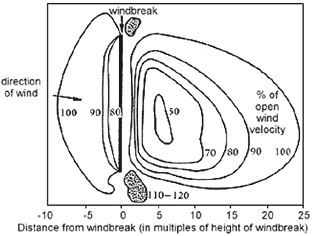|
Gaps and End Effects
Wind behaves like a fluid. When obstructed, wind speed will
increase through any gaps, over the top and around the ends
of the obstruction. This means that wind speed can actually
be higher near the end of a belt or even under the canopy
of the trees than it is in the open. The following diagram
shows how the wind speed can be as much as 20% higher near
the end of the belt.

Reference: Reid, R. and Bird, P.B. (1990),'Shelter'
in Trees for Rural Australia, ed. K.W. Cremer, Inkata Press
Melbourne, pp 319-335.
It is generally recommended that shelterbelts be as long as
possible. Shorter belts will be very ineffective due to wind
curling around each end of the belt. Ideally, shelterbelts
should form a continuous network that links into existing
vegetation to eliminate ends altogether. Farmers need to consider
how they might reduce the creation of gaps and ends. Gates
should be located in sheltered areas such as the point at
which two belts meet. If this is not possible the width of
the shelterbelt could be increased or additional shelter trees
established around the gateway.
Single
Row of Eucalypts
Back to top
|
